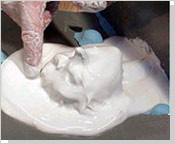 This is very specialized process used for the manufacture of non-ferrous alloy castings. It comes with smooth surfaces, intricate details and greater dimensional accuracy
This is very specialized process used for the manufacture of non-ferrous alloy castings. It comes with smooth surfaces, intricate details and greater dimensional accuracy
Model or master pattern is first made by drawing or CAD file, Stereolithography, traditional hand crafted or machined. The model is engineered to include (A) Metal shrinkage.(B) Mold taper (if required). A plaster made of gypsum or calcium sulfate, is mixed with talc, asbestos, sand and sodium silicate and water to make a slurry. The slurry is sprayed on the surfaces of the pattern halves.
It takes less than 15 minutes for the slurry to form the mold. The molds are extracted from the pattern, and then dried in an oven. The cores and mold halves are assembled. The molten metal gets poured in the molds. After cooling, the plaster broken and the cores are washed thoroughly.
Features of Plaster Mold Casting:- Casting size: small to medium ranging in weight from 30 g (1 oz) to 7 kg (15 lb)
- Section thickness: can be as small as 0.6 mm (0.025 in) .
- Tolerance:0.2 % linear.
- Draft allowanceis 0.5-1.0 degree.
- Surface finish:1.25 µm to 3 µm (50 µin to 125 µin) rms.
Application of Plaster Mold Casting:
Materials with low melting points such as aluminum, copper, magnesium and zinc can be cast by this process. Can be used for making quick prototype parts as well as limited production parts.
In the Industrial Process of Plaster Mold Casting, three variants are generally used. They are the following:Conventional Plaster Mold Casting Process
A slurry made up of Plaster of Paris with water is poured over a permanent pattern that is contained inside a molding box. After the setting process, a rigid mold is produced. The pattern is then stripped, dried at a high temperature to remove watery part. The metal is then cast into the mold. The mold here is strong and dense but impermeable in nature. So vacuum or pressure assistance is needed for complete filling of the mold by the metal.
The Foamed Plaster ProcessIt produces permeable molds by the presence of air in the slurry at the mixing stage. A mold is made that contains air bubble as half of its volume. This increases the permeability. It also helps in more economical use of the plaster. But the inherent strength of the mold is reduced.
The Antioch ProcessThe requirement to process the molds in a steam autoclave makes the Antioch process very special. Mold permeability is given by a unique granular structure. The density of molds manufactured by this process is stronger than foamed plaster but weaker than conventional plaster molds.
Advantages of Plaster Mold Casting Process- Can produce complex shapes.
- Thin section casting.
- Exact copying of pattern detail.
- Dimensionally accurate castings.
- Good surface finish.
- Minimum residual stresses and distortion in castings.
Limitations
- Poor productivity as it has lengthy processing problems.
- Close monitoring of the production process.
- The problems of poor mold permeability.
- Impaired mechanical properties a possibility as a result of slow cooling of the casting.
